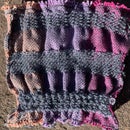Introduction: Weekly 4: Dynamic Wefts
this week we were exploring more complicated patterns on our cricket looms by experimenting with different and unusual wefts. We were tasked with making soft heddles out of yarns and coming up with different patterns to fit the particular weft.
Supplies
Cricket loom
yarn for warp
unusual materials for the weft (in my case, shoelace, wires and grass)
Step 1: Warping the Loom
I started by warping my loom using a warp rack shown in the picture. I'm not going to describe in detail this process, but the most important part is using the sticks to hold the warps in order without tangling. once transferring the warp to the loom it is crucial to make sure the tension on all the yarn is even and tight otherwise there will be problems later (foreshadowing).
Step 2: Constructing Heddles
because we are using multiple heddles to create patterns, we can't just use the heddle that comes with the cricket loom. We started by first trying to use paperclips as the heddle but found it would grab on the other warps and wouldn't work. next, I tried to laser cut heddles that could be easily swapped by putting the selected warps in the little eyelets. I think this could have worked with a bit more prototyping but instead, we just used what people have been using for thousands of years; yarn heddles. This proved to work well for a short while...
Step 3: Start Weaving
I started with a tabby weave by lifting the first and the third heddle, and then the seconds and the fourth heddle. It started out working fine by only missing a few warps here and there, but the pattern was visible...
Step 4: Adding Fun Wefts
After a few rows of tabby, I started to incorporate the unusual wefts. it started out fine with adding blades of grass with a twill pattern. I found it interesting because the grass went in easy one way, but if you inserted the grass "against the grain" it had a barb-like tendency and struggled. after the grass, I used an alternating pattern of a shoelace and a jumper wire, also in a twill pattern.
Step 5: It All Went Wrong
After a while, it all started to go wrong... the heddles started to stretch and become uneven causing uneven tension on the warps. This uneven tension caused the warp to stretch unevenly and eventually stretched so much that I couldn't even see the shed. I tried my best to follow which warps to go over and under manually, it eventually became too hard to keep a pattern going
Step 6: Reflection
Although the weave ended up being a bit of a disaster, there is was still much to take away from this activity. First of all, weaving is really hard. People have mastered weaving for thousands of years, yet it is still a craft that takes so many patients and practice. It is comforting to think that ancient Egyptians also got frustrated and wanted to throw their loom out the window when weaving. My second takeaway was that the thickness of the weft matters when constructing a pattern. For example, if you throw a shoelace through and immediately follow it with a thin wire, it will not show the pattern as you see it on Adacad. Through all of the struggles, however, I had a fun time trying to get the loom to work and putting random materials in fabric.













